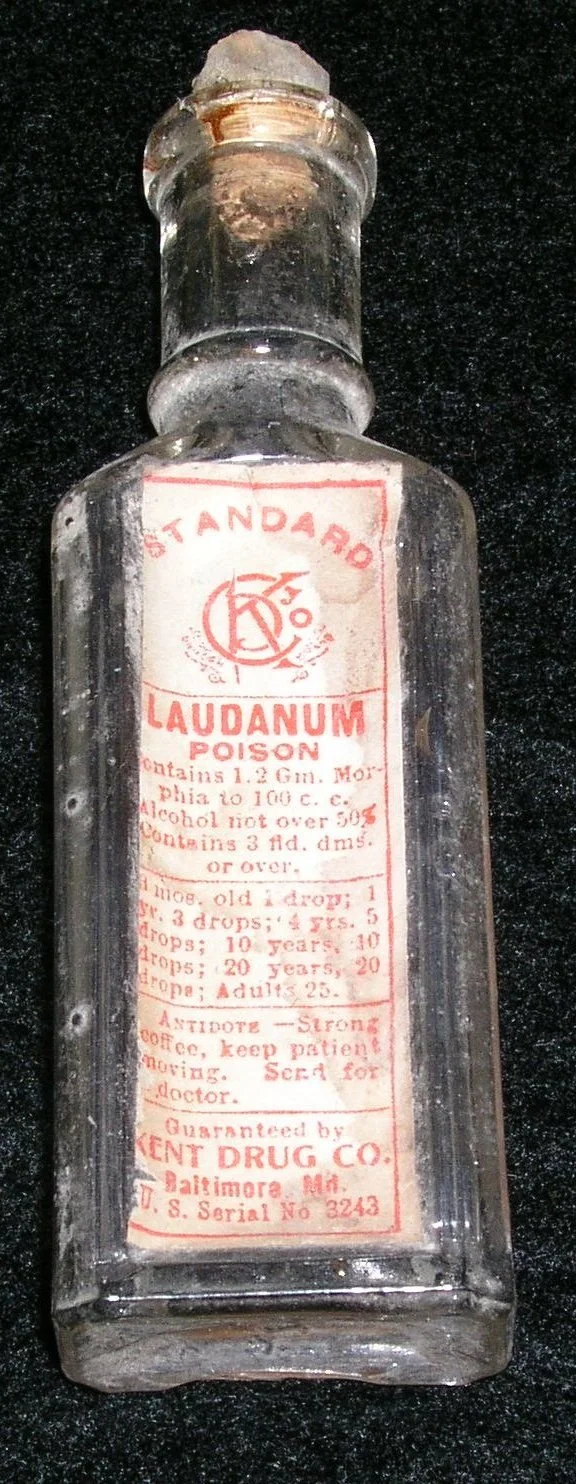Victorians Gave Babies Opium for Bedtime 😬—A Cautionary Tale About “Quick Fix” Sleep
TL;DR: In the 1800s, parents sometimes dosed babies with laudanum (opium) to knock them out. Sedation ≠ healthy sleep. Today’s quick fixes can make the same mistake. Instead, use tools that protect sleep architecture—the natural cycles that restore the brain and body.
Did you know that in the 1800s, a common “bedtime routine” in Britain and America was a few drops of laudanum—an over‑the‑counter tincture of opium in alcohol? Apothecaries sold it for headaches, heartbreak, coughs, colic…and insomnia. Patent remedies with charming names like Godfrey’s Cordial and Mrs. Winslow’s Soothing Syrup promised angelic sleep for fretful infants and exhausted parents. The results could be immediate—and disastrous.
19th-century laudanum bottle (public domain / archival)
Why It Caught On
Life was brutally tiring: long factory shifts, crowded tenements, smoky air, no refrigeration (hello, midnight food sickness), and relentless child‑care with little medical guidance. Laudanum did quiet things down. It dulled pain, softened anxiety, and blurred noisy nights into oblivion. Writers and artists used it, dockworkers used it, new mothers used it. When the world was too loud or too sharp, the bottle seemed to offer mercy.
But sleep from opium isn’t rest—it’s sedation. Diaries and inquests from the period read like a slow‑motion warning label: dependency, escalating doses, accidental poisonings—especially in infants whose tiny bodies couldn’t safely metabolize the drug.
Laudanum label marked ‘Poison’ (historic bottle)
The Turning Point
By mid‑century, physicians sounded alarms, and regulators (late, but finally) moved:
1868 (UK): The Pharmacy Act restricted over‑the‑counter opiates.
1906 (US): The Pure Food and Drug Act required honest labeling.
1914 (US): The Harrison Narcotics Tax Act imposed tight control.
Public opinion shifted. What felt like a miracle cure had cast a long shadow.
Period advertisement for laudanum / paregoric
The Pattern We Still Fall For
When sleep feels impossible, fast often beats safe, and marketing beats physiology. Sedation can silence symptoms while deep sleep—the slow‑wave, memory‑consolidating, tissue‑repairing kind—remains starved. Quick fixes can hide the real culprits: stress, irregular schedules, late caffeine, evening light exposure, or a bedroom soundscape that keeps the brain on alert.
Key idea: If a product promises “effortless sleep in seconds,” ask which system it’s acting on. Is it nurturing healthy sleep architecture (NREM/REM cycles), or just muting your senses?
What Helps Instead (and Why)
Even in the 19th century, people discovered gentler levers: cooler bedrooms, darker curtains, predictable routines—and sound. A steady, broadband hush (think: crackling hearth, later a whirring fan) can mask street noise without drugging the nervous system. That insight powers today’s safer “sleep tech”:
Pink or brown noise to blur irregular sounds and reduce micro‑arousals.
Nature soundscapes (rain, surf, wind in trees) that cue safety and calm.
Rhythmic audio that can encourage slower breathing and down‑shifted heart rate.
These support genuine restoration rather than simply switching consciousness off.
Try‑This Guide: Build a Sleep‑Supportive Soundscape
Aim for steady, broadband sound. Sudden peaks wake the brain.
Keep volume modest. You should hear it, not compete with it.
Time it right. Start 15–30 minutes before lights‑out and keep it continuous.
Mind the mix. If using nature sounds, choose tracks without dramatic crescendos.
Pair with good hygiene. Dim light 60–90 minutes before bed; avoid caffeine after noon; keep the bedroom cool (~60–67°F/15–19°C).
The Takeaway
Be curious, not desperate. Victorians didn’t have today’s language for sleep architecture. We do. Choose tools—especially audio—that protect the structure of sleep instead of suppressing awareness.
Friendly Reminder
This article is educational and not medical advice. If you’re dealing with insomnia, sleep apnea, or medication questions, talk with a qualified clinician.


